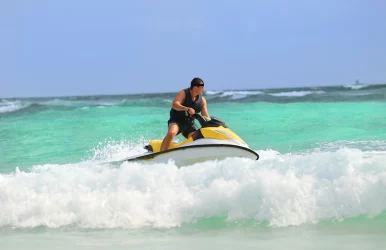8 Reasons To Spend Your Spring Vacation In Pigeon Forge
BY Arnab Mar 9, 2023
Spring is an epic time to be in Pigeon Forge. From soaring above the Smoky Mountains on a zip line to admiring the stars from your cabin's patio, you can't beat the scenic beauty of this mountain town. And what if you bump into your favorite celebrity on the Parkway? Now that's dreamy. Moreover, Pigeon Forge is perfect for a spring getaway. It has everything you're looking for, from waterfalls cascading down riverbeds to inviting hiking trails and thrilling adventures. But if you're still inconclusive about whether you should visit Pigeon Forge this spring, here are some convincing reasons. Eight Prime Reasons To Spend Your Spring Vacation In Pigeon Forge 1. Perfect Weather for Outdoor Fun Spring vacations aren't complete without some outdoor fun. But you can easily get your daily dose of Vitamin D in Pigeon Forge. The temperature ranges between 70-80 degrees Fahrenheit, making it ideal for various activities. Whether you want to kayak down the river or stroll in a park on a lovely spring day, Pigeon Forge is the ultimate outdoor paradise. Hiking is especially popular in the spring and summer as flora and fauna come to life. There are plenty of trails that provide stunning views of the majestic Smoky Mountains, and you can also explore caves, go fishing, and ride a horse – perfect for the whole family. However, please note that spring and summer are Pigeon Forge's peak seasons. So, book your tickets and accommodation early. 2. Exciting Dinner Shows This town also hosts one of the best dinner shows in Pigeon Forge, Dolly Parton's Stampede. It is more than just a dinner show; it's a lively and interactive experience that immerses guests in the heart of friendly competition. As soon as you enter the arena, the atmosphere shifts, and you feel as though you've been transported back in time. The show is a dazzling spectacle of horsemanship, music, and dancing, with talented performers dressed in authentic costumes. Highlights of the evening are undoubtedly the thrilling horse riding stunts, live animals, musical productions, and celebration of American patriotism. As you watch, you can also enjoy a delicious feast of Southern-style cuisine. 3. The Thrill of Amusement Parks Dollywood - the star attraction of Pigeon Forge - needs no introduction. It is Tennessee's biggest-ticketed tourist spot that'll leave you humming Dolly Parton's tunes for days. The park has a charming mix of southern hospitality and thrill rides that'll get your heart racing faster than a rodeo bull. The Wild Eagle roller coaster is a must-ride, a steel beast that sends you soaring through the mountains at 61 mph. And so is the FireChaser Express, which takes you on a wild ride of twists and turns. If speed isn't your cup of sweet tea, you can ride on the Dollywood Express, a steam engine train that winds through the park's picturesque landscape. 4. Vibrant Festivals and Events Pigeon Forge is abuzz with excitement as its current events and festivals bring together locals and tourists alike. If you’re planning to explore Pigeon Forge’s blooming springtime, you can’t miss Dollywood Flower and Food Festival. Horticulturists display stunning large flower sculptures that will surely leave you in awe. Similarly, the Spring Rod Run showcases vintage cars and hot rods, revving up the engines of auto enthusiasts. It'll be car heaven in the city this season. Or, you could visit the Blooms and Tunes at Anakeesta, a spectacular live music event featuring local bands. 5. Breathtaking Views Everywhere You Look Soothe your eyesight with spectacular views in Pigeon Forge. From the majestic mountaintops to the panoramic overlooks of the Smoky Mountains, there's no shortage of natural beauty in town. You can also visit Clingmans Dome to get up close and personal with the region's stunning vistas. It's the highest mountain at an hour-long drive from Pigeon Forge. Whether you go up for a romantic sunrise or watch the fiery sunset, it's the perfect spot to take pictures and admire Mother Nature's beauty. The Great Smoky Mountain Wheel at The Island provides an amazing bird's eye view of the city. The 200-foot-tall Ferris wheel is illuminated with thousands of LED lights, creating a breathtaking spectacle in the night sky. 6. Family-Friendly Activities Brimming with family-friendly fun, Pigeon Forge is the ideal getaway for families with kids. You can walk the red carpet at the Hollywood Wax Museum or enjoy a meal with live animals in Big Top Arcade & Fun Park. The city also has some great waterparks and go-kart tracks. Downtown Flavortown is the perfect place to test your skills if you're into bowling. Ripley's Aquarium is another great option. Stroll through the Shark Lagoon, Turtle Bayou, and other fascinating exhibits as you learn about undersea life. This watery wonderland will keep your kids entertained for hours. 7. Food for Every Palate The selection of restaurants in Pigeon Forge is second to none. You will surely be well-fed, from traditional Southern specialties to gourmet pizza. Fried chicken and steaming BBQ are two of the best must-try dishes in town. But that's not all. Pigeon Forge restaurants offer mouth-watering steaks, filling burgers, and delicious seafood options. The city has plenty of international cuisines to savor if you want something more exotic. Some must-visit restaurants in Pigeon Forge include The Old Mill, Log Cabin Pancake House, and Big Daddy's Pizzeria. For a truly unique culinary experience, head to the Apple Barn & Country Store. Here you can try delicious apple fritters, pies, and ciders. Or how about a cup of their famous apple butter? 8. Pigeon Forge is Pet-Friendly Some of us have furry travel companions, and Pigeon Forge is a pet-friendly destination. That means your four-legged friends can join you on vacation – how cool is that? Be sure to check the pet policies of your accommodation before your visit. There are plenty of dog-friendly parks, restaurants, and attractions in town, so your furry pal can have a great time too. If you're looking for exciting places to take your pup, The Island in Pigeon Forge has several pet-friendly spaces. There are even special dog treats and snacks available at the shops. Wild Bear Tavern, Blue Moose Burgers & Wings, and Hard Rock Cafe are all great options for dining with your pet. You can also take them out shopping. The Big Dog Sportswear, for instance, is a pet-friendly store where you and your pup can pick up some cool gear. Conclusion It certainly looks like Pigeon Forge is a promising destination. Attractive and scenic, the city has something for everyone. From majestic mountains to incredible attractions and family-friendly activities, Pigeon Forge will surely make your spring vacation a blast. But before you load your car, pack all the essentials. You'll need layers, even during springtime. The mountains can get chilly, so be prepared. Read Also: 6 Best Family Holiday Destinations In India Tips to Help You Plan your Holidays to Morocco Top 10 Hot Springs Near Denver You Can Visit In Winter














